bay bridge
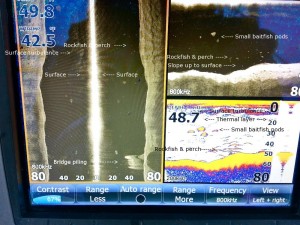 We interrupt this conservation blog with a fishing report. Nah, it’s the other way around. Chesapeake Light Tackle will always be first and foremost a fishing-report website. Well, fishing reports along with some occasional good advice about gear and techniques. Don’t worry – I won’t be lightening up on Maryland DNR’s bad decision to increase rockfish harvest by 14 percent in the face of impending cuts, but I wanted to let you know that I have been lighting up some local fishing spots lately. It’s the holidays, and the weather hasn’t been great, but there are still some fish to be caught for those who are willing to brave the elements and cast for them. The warm water discharges have been hit-and-miss lately. Most of the anglers who have visited them have been disappointed, but once in a while, I hear of a good fish or two being caught. The same goes for the deep holes at the mouths of the rivers and also for my go-to-winter honey hole: Light Tackle University (“LTU”). Read More!
We interrupt this conservation blog with a fishing report. Nah, it’s the other way around. Chesapeake Light Tackle will always be first and foremost a fishing-report website. Well, fishing reports along with some occasional good advice about gear and techniques. Don’t worry – I won’t be lightening up on Maryland DNR’s bad decision to increase rockfish harvest by 14 percent in the face of impending cuts, but I wanted to let you know that I have been lighting up some local fishing spots lately. It’s the holidays, and the weather hasn’t been great, but there are still some fish to be caught for those who are willing to brave the elements and cast for them. The warm water discharges have been hit-and-miss lately. Most of the anglers who have visited them have been disappointed, but once in a while, I hear of a good fish or two being caught. The same goes for the deep holes at the mouths of the rivers and also for my go-to-winter honey hole: Light Tackle University (“LTU”). Read More!
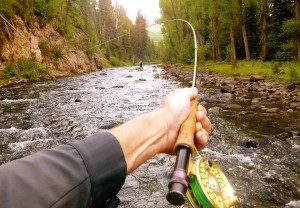 There’s nothing better for sharpening your light-tackle skills than scaling down and hitting the fast water in the creeks. Almost all I know about fishing I learned first in East Tennessee mountain streams. Tactics like swimming a lure with the current, casting to the deep side of cover, matching the hatch, looking for the dark water, minimizing terminal tackle, and the importance of stealth are all stream fishing techniques that translate easily to light tackle casting in the Chesapeake Bay. As much as I love the Bay and targeting the many species that live here, there are times when the call of the creeks is so great that I have to drop everything and go. Over the past couple of weeks, I’ve had a lot of fun stream fishing at some very scenic locations.
There’s nothing better for sharpening your light-tackle skills than scaling down and hitting the fast water in the creeks. Almost all I know about fishing I learned first in East Tennessee mountain streams. Tactics like swimming a lure with the current, casting to the deep side of cover, matching the hatch, looking for the dark water, minimizing terminal tackle, and the importance of stealth are all stream fishing techniques that translate easily to light tackle casting in the Chesapeake Bay. As much as I love the Bay and targeting the many species that live here, there are times when the call of the creeks is so great that I have to drop everything and go. Over the past couple of weeks, I’ve had a lot of fun stream fishing at some very scenic locations.
I’ve always had an interest in history and I’m especially intrigued by the Civil War. It’s not because of romantic notions about the ante-bellum South, but because it was such a seminal period for our country. I grew up kicking minie-balls around in the dirt near my farm in Mooresburg, Tennessee. Years later I was surprised to learn that the property I grew up on was the camp of General James Longstreet’s Army of Northern Virginia in the winter of 1863.  That led me to swinging a metal detector and turning up a nice collection of Confederate relics including some well-presevered belt plates, bullets, and buttons.
That led me to swinging a metal detector and turning up a nice collection of Confederate relics including some well-presevered belt plates, bullets, and buttons.
When I moved to Maryland, I visited several National Civil War Parks but I somehow missed the Antietam Battlefield near Sharpsburg. One of the most interesting stories from the killing fields of Sharpsburg is the battle of Burnside’s Bridge where 12,000 Federal troops were held at bay by 500 determined Georgians perched on the bluffs above the creek. Two weekends ago, I set off toward Antietam Creek to see if there are any fish below Burnside’s Bridge. Read More!
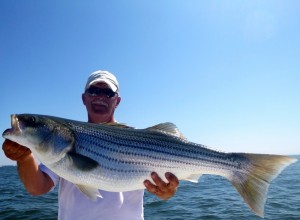 Congratulations to Rich Jenkins, 2013 Champion of the Kent Narrows Light Tackle Catch-&-Release Tournament. Rich fished with Jamie Clough, Jon Griffiths and me onboard my 27 Judge CC Thunder Road and won the tournament with a wide-shouldered 34-inch striper caught about 1:00 PM Saturday afternoon. Coming off the win, I thought it might be helpful to post some recommendations for catching bigger striped bass in Maryland’s portion of the Chesapeake Bay in June.
Congratulations to Rich Jenkins, 2013 Champion of the Kent Narrows Light Tackle Catch-&-Release Tournament. Rich fished with Jamie Clough, Jon Griffiths and me onboard my 27 Judge CC Thunder Road and won the tournament with a wide-shouldered 34-inch striper caught about 1:00 PM Saturday afternoon. Coming off the win, I thought it might be helpful to post some recommendations for catching bigger striped bass in Maryland’s portion of the Chesapeake Bay in June.
Topwater – Look around high-current points where there is access to deep water. Submerged rocks and other cover are a plus. Set up downstream and fan-cast into the direction of the current starting closest to shore. Look for the rip, that is a change in the waves around the point and work that area hard. On calm days, use a spook. In rougher water, try a big popper. Heddon Super Spooks, Lonely Angler Zipsters, and Stillwater Smackits are great lures for this time of year. Read More!
![darthsidious[1]](http://www.chesapeakelighttackle.com/wp-content/uploads/2013/02/darthsidious1-300x248.jpg) Every angler I know has lost the biggest fish they ever hooked. Well, at least we think we have. A fish that breaks a line or pulls a hook immediately grows twenty pounds in my mind. It’s in every fisherman’s nature to believe he or she had a shot at a new world record, but it got away. Nothing makes a fish bigger than almost getting caught. I had just that experience a few days ago – you know, a big fish, an epic battle, and a broken line – so I thought it might be interesting to take another look at some of the things we do wrong to make sure we never catch that fish of a lifetime.
Every angler I know has lost the biggest fish they ever hooked. Well, at least we think we have. A fish that breaks a line or pulls a hook immediately grows twenty pounds in my mind. It’s in every fisherman’s nature to believe he or she had a shot at a new world record, but it got away. Nothing makes a fish bigger than almost getting caught. I had just that experience a few days ago – you know, a big fish, an epic battle, and a broken line – so I thought it might be interesting to take another look at some of the things we do wrong to make sure we never catch that fish of a lifetime.
It’s big fish season on the Chesapeake Bay. The coldest months of the year are the absolute best times to catch & release striped bass. Stripers are hardier in the winter. They’re more muscular, carry more fat, and are almost guaranteed to survive when properly handled and released. Additionally, winter is a great time to fish the Bay because it’s almost free of boat traffic. Wildlife sightings are more common. Bald eagles are frequent. Sea ducks are everywhere. On cold, clear, calm days colors are more vivid, the water reflects more spectacularly, and we can see things farther away. Some days you can see for miles across the glass where unobstructed views of the horizon make it nearly impossible to tell where the water ends and the blue sky begins. It’s a fantastic time to enjoy the Chesapeake in all it’s winter splendor. It’s beautiful. So, c’mon, you wouldn’t want to spoil all that serenity with the biggest fish of your lifetime, would you? Here are some sure-fire things you can do to make sure you lose that bad boy! Read More!
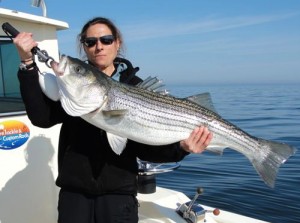 In the fifty years or so I’ve had to observe the behavior of fishermen, I’ve noticed a few trends. While collecting thoughts for my next book, I’m forming a list of traits that I think good fishermen have in common. In the book, I’ll concentrate primarily on gear and tackle but I also want to spend some time examining habits and attitudes that successful anglers share. You know, the right stuff. One penchant stands out above all the rest – good fishermen like to release fish. Not only do they like to let them go, but they look for ways to insure they survive once they swim away. Accomplished anglers find satisfaction in returning a fish to the water and they enjoy the thought that other fishermen will also have the opportunity to experience the thrill of a trophy catch.
In the fifty years or so I’ve had to observe the behavior of fishermen, I’ve noticed a few trends. While collecting thoughts for my next book, I’m forming a list of traits that I think good fishermen have in common. In the book, I’ll concentrate primarily on gear and tackle but I also want to spend some time examining habits and attitudes that successful anglers share. You know, the right stuff. One penchant stands out above all the rest – good fishermen like to release fish. Not only do they like to let them go, but they look for ways to insure they survive once they swim away. Accomplished anglers find satisfaction in returning a fish to the water and they enjoy the thought that other fishermen will also have the opportunity to experience the thrill of a trophy catch.
I love to eat fish. I just returned from a week-long fishing trip to the Abacos Islands where my sons and I ate the fish we caught every day. I don’t begrudge anyone the opportunity to eat their catch, but every angler has to release fish from time to time. Better anglers can’t possibly eat all the fish they catch, nor do they want to. I’ve written about this in the past, so instead of going into a step-by-step breakdown of best-practices, I thought I’d try to make it a little more fun by turning it into a quiz. Think you have a good handle on how to take care of the fish you plan to release? Check it out: Read More!
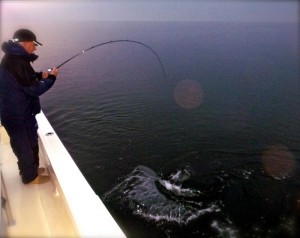 It’s January on the Chesapeake Bay. It’s freezing. It’s windy. It’s snowy-sleety-foggy-and-rainy-miserable. It’s a fine time to stay home in front of a comfortable fire and dream of warmer seasons. On the other hand, these are perfect conditions to catch & release trophy striped bass in Maryland. To get ’em, you gotta want ’em. And I mean, really want ’em.
It’s January on the Chesapeake Bay. It’s freezing. It’s windy. It’s snowy-sleety-foggy-and-rainy-miserable. It’s a fine time to stay home in front of a comfortable fire and dream of warmer seasons. On the other hand, these are perfect conditions to catch & release trophy striped bass in Maryland. To get ’em, you gotta want ’em. And I mean, really want ’em.
When it comes to winter fishing, you have to be motivated enough to put up with some misery. One of the definitions for dedication in Webster’s Online Dictionary is, a solemn commitment of your life or your time to some cherished purpose or goal. Everyone I know who is good at anything got that way because of their dedication. Simply put, the key to success in any endeavor is an extreme level of commitment. Now, let’s talk rockfish.
It’s miserable out there. It’s striped bass weather. If catching and releasing big fish is your cherished goal, why aren’t you fishing?


